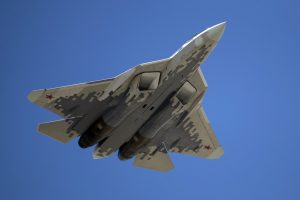The Russian Air Force is still expected to receive the first batch of serial-produced Sukhoi Su-57 fighter aircraft, Russia’s first purported indigenously designed and built fifth-generation stealth fighter, in 2020, according to a senior Russian defense industry official.
“Large-scale work awaits us in 2020 to stabilize the aircraft industry,” the head of Rostec, Sergei Chemezov, was quoted as saying on December 26 by TASS news agency. “The first large-scale deliveries of the fifth-generation Su-57 aircraft will begin.”
A Su-57 crashed on December 24 some 120 kilometers from the Komsomolsk-on-Amur aircraft plant in Russia’s Far East during a flight test. According to a source, the aircraft involved in the incident was the first serial-produced Su-57.
Earlier this year, Russian defense officials repeatedly reiterated that the first Su-57 in serial configuration will be handed over to the Russian Air Force by the end of 2019. Initially, the service was expected to take delivery of two Su-57s in 2019 and two more in 2020.
However, the Chief of Staff, of the Russian Armed Forces, First Deputy Defense Minister General Valery Gerasimov, stated in December that the Su-57 was still undergoing flight tests. He also revealed that the Su-57, recently codenamed the “Felon” by NATO, has undergone a “second combat testing” in Syria “during which all tasks planned were successfully performed.” The aircraft first conduced combat missions in Syria in early 2018.
The Russian Air Force is currently testing 10 Su-57 prototypes, four of which reportedly have flown combat missions in Syria. It is also using three airframes for ground testing.
All Su-57 prototypes have been fitted with a derivative of the Russian-made Saturn AL-41F1S engine, the AL-41F1, an older aircraft engine also installed on the Sukhoi Su-35S Flanker-E. It is unclear when production will shift to the more advanced Saturn izdeliye 30 engine.
Deputy Defense Minister, Alexei Krivoruchko, announced this June that the United Aircraft Corporation (UAC) is ready to mass-produce the Su-57. In July, Russian defense industry officials revealed that serial production of the Su-57 has officially begun without, however, offering details.
As I explained elsewhere:
In May 2019, Russian President Vladimir Putin declared that the air force will receive 76 Su-57s by 2028. A contract to this effect was signed this July. Notably, the previous year the Russian Ministry of Defense (MoD) had announced that it will not serial-produce the Su-57.
One reason cited for the reversal of the MoD decision reportedly has been reduction of per-unit cost of Su-57 and associated equipment, which purportedly went down by about 20 percent.
The Russian government has reportedly offered the Chinese People’s Liberation Army Air Force (PLAAF) an export variant of the aircraft, designated Su-57E. Algeria, Iran, Turkey, and Pakistan have also expressed interest in aircraft. Russia has also repeatedly offered the aircraft to India, which withdrew from co-development and production of the Su-57, known in India as the Perspective Multi-role Fighter (PMF), in 2018. The Su-57E received export clearance earlier this year.

































